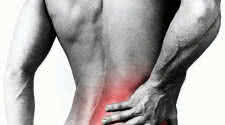Avoid Lower Back Pain & Injury from Squats with Smith-Machine Squats

There are many options and variations to build powerful thighs
If you tend to injure your lower back when squatting with a barbell, you should 1) check your exercise
form, 2) try to bring up the strength of your lower back, 3) find alternative methods of training your
thighs, and 4) use safe methods of over-loading your thighs without putting the lower back at risk.
Let's quickly discuss some of the problems you may be encountering as you squat. Your lower back seems
to be a "weak link "in your body chain of strengths and weaknesses. I would definitely suggest doing
deadlifts, good mornings and hyperextensions regularly to help bring up the strength and development of
your lower back As this area gains strength, you'll find it easier to isolate and overload your thighs
as you squat. Keep in mind that strong abdominals are also important when squatting, so try to strike a
balance between strong spinal erectors and strong abs.
Before you ever squat, make sure your back is up to the attempt. Warm up well with several light high-rep
attempts. Wrap your lower back with a neoprene "heat" belt, followed by a strong weight belt to give your
it extra support and security. The double support of the neoprene belt and the weight-training belt
should give you extra confidence that your lower back is tight and well supported.
As far as exercise form goes, you must squat in such a way as to place the overload on the thighs, not
on the lower back, hips or glutes. One reason so many people suffer lower-back injuries is that they do
not retain an arch in the lower back as they descend with the bar Instead they lean forward in a half
good morning/half full squat motion with their head between their legs, allowing the lower back to round
over Then they ascend to the finish position, coming up glutes first, while straightening the back. This
rocking back and forth action plays havoc with the lower back. A good morning type of action every rep is
very stressful to the spinal erectors and lumbar muscles. Squatting this way not only causes pain, but
also puts the lower back in a very precarious position and make it vulnerable to injury If you do not have
access to a Smith machine and can only squat with a barbell, try presetting the lower back and locking it
into one position throughout the squatting motion. PP7ile keeping your back flat and the lower back arched,
tilt forward at the waist 10 or 15 degrees. Sustain the position both as you descend to the full squat and
as you ascend to the finish position. This way there is no way you can rock back and forth.
If you do have access to a Smith machine, use it rather than a barbell for squatting. This is a touch
purer quad exercise than squatting with a bar; and safer too. Don't feel as though it is an inferior thigh
developer. Former Mr. Olympia Dorian Yates squats using the Smith machine exclusively and his thighs are
massive beyond belief. When squatting with the Smith machine, Sty to place your feet ahead of the bar on
your shoulders. This allows you to squat deeply without rounding the back In fact, the farther forward you
place your feet, the more straight you can keep your back It becomes possible to actually lean bock into
the bar; as doing a very steep angled hack squat, so there is little or no stress to the lower back Smith-machine
squatting in this manner becomes a very pure quad exercise.
You can further protect your spinal column and lower back when doing Smith-machine squats by using the
pre-exhaust principle. Performing either leg extensions, 45-degree leg presses. hack squats, sissy squats
or a combination of these exercises prior to squatting enables you to put less pressure on the spinal
column and still effectively overload the thighs. I suggest using the pre-exhaust principle every other
workout when training thighs. One leg workout do 5 sets of 8 to 15 reps of straight- set Smith-machine
squats using the heaviest possible weights followed by other movements that do not put stress on the lower
back - such as hack squats, 45-degree leg presses and sissy squats. The next leg workout pre-exhaust your
thighs by first performing leg extensions, leg presses and/or hack squats prior to Smith-machine squats
(for example, leg extensions 1 x 15-20, 45- degree leg presses 1 x 35-50, Smith-machine squats 1 x 10-15).
This is very grueling thigh- training and should more than offset any reduction in weight used and give your
thighs the kind of stimulation they need to grow.
When using the Smith machine for squats you can also do triple-drop sets. This method allows you to give
your thighs a terrific workout with less than maximal weights. if possible, have a partner strip weights
from the bar to save time.